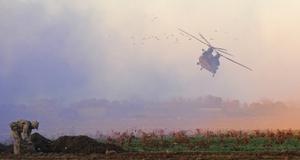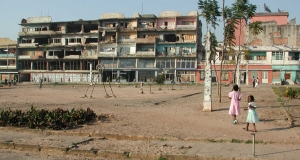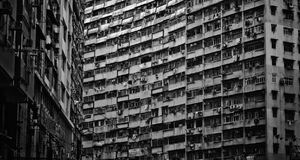Corruption and Graft in Post-Conflict Afghanistan
By
2015, Vol. 7 No. 07 | pg. 4/4 | « ConclusionAfghanistan suffers from corruption and graft at all levels, all the way from truck drivers giving baksheesh to police officers to pass a security checkpoint to people using nepotistic connections to well-connected individuals in order to become judges without a law degree to bureaucrats extorting aid from international donors. As a consequence, the country’s endemic corruption has only reinforced its security quagmire while severely diminishing its economic growth potential. Due to the causes of corruption in the war-torn country primarily stemming from post-conflict state weakness and a lack of accountability mechanisms, a three-part solution is required: rebuilding legitimacy within the Afghan judiciary, ANP and bureaucracy through strengthening monitoring capabilities, improving overall agent quality and bettering incentive structures; focusing aid programs towards capacity building and anti-corruption efforts while simultaneously increasing monitoring efforts; and coopting the Afghan people and civil society institutions in an anti-corruption partnership. Any sort of action, however, requires decisive action from President Ghani and assistance from the international community. Reducing corruption levels would pave the way for stronger democratic institutions and free markets in Afghanistan. If successful, anti-corruption efforts employed in Afghanistan would prove useful in targeting corruption in other conflict-ridden, developing nations like Somalia and Sudan. Regardless, action now will promote economic development and stability within a country that, after decades of war and poverty, is desperately seeking it.References“Afghan perceptions and experiences of corruption: main findings.” (2010). Retrieved June 01, 2015, from http://www.iwaweb.org/corruptionSurvey2010/Main_findings.html Audit of UNDP Afghanistan (Rep. No. 1417). (2015, March 24). Retrieved http://audit-public-disclosure.undp.org/view_audit_rpt_2.cfm?audit_id=1417 Boucher, A. J., Durch, W., Middyette, M., Rose, S., & Terry, J. (2007, March). Mapping and Fighting Corruption in War-Torn States (Rep.). Retrieved http://www.u4.no/recommended-reading/mapping-and-fighting-corruption-in-war-torn-states/ Braithwaite, J., & Wardak, A. (2012, December 14). Crime and War in Afghanistan. British Journal of Criminology Advance Access, 8-14. doi:doi:10.1093/bjc/azs065 Brummet, J. (2009, December 16). SIGAR: Afghanistan's High Office of Oversight needs significantly strengthened authority, independence, and donor support to become an effective Anti-Corruption Institution (Rep. No. Audit-10-2). Retrieved June 1, 2015, from https://www.sigar.mil/pdf/audits/2009-12-16audit-10-02.pdf Chene, M. (2012, September 7). U4: Anti-Corruption Resource Centre (Issue brief). Retrieved from Marie Chene, "Tackling judicial corruption in Afghanistan," U4: Anti-Corruption Resource Centre, September 12, 2012, Judicial Appointments, accessed June 01, 2015, http://www.u4.no/publications/tackling-judicial-corruption-in-afghanistan/. Coleman, B. B., Major. (2011). The Impacts of corruption on economic development in Afghanistan: A study of the effects of nepotism and bribery (Unpublished master's thesis). U.S. Army Command and General Staff College. Retrieved June 1, 2015, from http%3A%2F%2Fwww.dtic.mil%2Fcgi-bin%2FGetTRDoc%3FAD%3DADA557232 Corruption by Country / Territory. (2014). Retrieved June 01, 2015, from http://www.transparency.org/country#AFG Corruption has become Afghanistan’s second biggest problem. (2014, May 28). Retrieved June 01, 2015, from http://www.iwaweb.org/ncs/index.html Corruption in Afghanistan: Bribery as reported by the victims (Rep.). (2010, January). Retrieved June 1, 2015, from United Nations Office on Drug and Crime website: http://www.unodc.org/documents/data-and-analysis/Afghanistan/Afghanistan-corruption-survey2010-Eng.pdf Corruption in Afghanistan: Recent patterns and integrity challenges in the public sector (Rep.). (2013, October). Retrieved June 1, 2015, from http://www.unodc.org/documents/data-and-analysis/statistics/corruption/Corruption_Afghanistan_2013.pdf Doing Business 2013: Smarter regulations for small and medium-sized companies (Rep. No. 73844). (2013). Retrieved from http://www-wds.worldbank.org/external/default/WDSContentServer/WDSP/IB/2012/12/26/000425962_20121226142736/Rendered/PDF/NonAsciiFileName0.pdf Gais, H. (2015, March 30). How Ashraf Ghani's government will address afghanistan's endemic problems. Retrieved June 01, 2015, from http://thediplomat.com/2015/03/how-ashraf-ghanis-government-will-address-afghanistans-endemic-problems/ Gebauer, M., & Volkery, C. (2010, January 19). Corruption in Afghanistan: UN report claims bribes equal to quarter of GDP. Retrieved June 09, 2015, from http://www.spiegel.de/international/world/corruption-in-afghanistan-un-report-claims-bribes-equal-to-quarter-of-gdp-a-672828.html Giustozzi, A., Franco, C., & Baczko, A. (2013). Shadow justice: How the Taliban run their judiciary (Rep.). Retrieved from http://www.iwaweb.org/_docs/reports/research/shadow_justice-how_the_taliban_run_their_judiciary.pdf Global Corruption Barometer 2013: Afghanistan. (2014). Retrieved June 01, 2015, from http://www.transparency.org/gcb2013/country/?country=afghanistan Goldstein, J. (2015, February 08). Police force in Afghanistan is studied for ties to Taliban. Retrieved June 01, 2015, from http://www.nytimes.com/2015/02/09/world/asia/police-force-in-afghanistan-is-studied-for-ties-to-taliban.html Goodman, M. B., & Sutton, T. (2015, March 17). Tackling corruption in Afghanistan: It’s now or never. Retrieved June 1, 2015, from https%3A%2F%2Fwww.americanprogress.org%2Fissues%2Fsecurity%2Freport%2F2015%2F03%2F17%2F108613%2Ftackling-corruption-in-afghanistan-its-now-or-never%2F Greenman, M. (2013, February). Curbing corruption in Afghanistan's courts. Georgetown Journal of Legal Ethics, 26(4), 2013th ser., 695-710. Retrieved June 1, 2015, from HeinOnline. High Office of Anti-Corruption. (2014). Retrieved June 01, 2015, from http://anti-corruption.gov.af/en/page/1733 Hussman, K., Lateef, S., & Macuane, J. (2008, Summer). OECD: Working towards more effective donor responses to corruption (Rep.). Retrieved June 1, 2015, from http://www.oecd.org/dac/governance-peace/governance/docs/45019669.pdf Karklins, R. (2005). The Role of the right Anti-Corruption strategy. In The system made me do it: Corruption in post-communist societies. Armonk, NY: M.E. Sharpe. Klitgaard, R. E. (1988). Policy Measures. In Controlling corruption. Berkeley: University of California Press. Labelle, H. (2012, July 06). Billions down the Afghan hole. Retrieved June 01, 2015, from http://www.nytimes.com/2012/07/07/opinion/billions-down-the-afghan-hole.html Laub, Z. (2014, July 4). The Taliban in Afghanistan. Retrieved June 01, 2015, from http://www.cfr.org/afghanistan/taliban-afghanistan/p10551 Lauri, A. D. (2013). Corruption, legal modernisation and judicial practice in Afghanistan. Asian Studies Review, 37(4), 527-545. doi:10.1080/10357823.2013.832112 Legon, A. (2009, June). Ineffective, unprofessional, and corrupt: The Afghan National Police challenge. Retrieved June 01, 2015, from http://www.fpri.org/articles/2009/06/ineffective-unprofessional-and-corrupt-afghan-national-police-challenge Marquette, H. (2011). Donors, state building and corruption: Lessons from Afghanistan and the implications for aid policy. Third World Quarterly, 32(10), 1878-1879. doi:10.1080/01436597.2011.610587 Mauro, P. (1997, February). Why worry about corruption? Retrieved June 09, 2015, from http://www.imf.org/external/pubs/ft/issues6/ Meagher, P. (2008, Summer). Service delivery in fragile situations: Key concepts, findings and lessons (Rep.). Retrieved from http://www.oecd.org/dac/governance-peace/conflictandfragility/docs/40886707.pdf Perlez, J. (2012, July 08). $16 Billion in civilian aid pledged to Afghanistan, with conditions. Retrieved June 01, 2015, from http://www.nytimes.com/2012/07/09/world/asia/afghanistan-is-pledged-16-billion-for-civilian-needs.html?_r=0 Rose-Ackerman, S. (1999). Economic Costs of Corruption. In Corruption and government: Causes, consequences, and reform (pp. 27-28). New York: Cambridge University Press. Rosenberg, M. (2012, November 26). Audit says Kabul bank began as ‘Ponzi scheme’. Retrieved June 01, 2015, from http://www.nytimes.com/2012/11/27/world/asia/kabul-bank-audit-details-extent-of-fraud.html Sarwary, B. (2012, February 2). Why Taliban are so strong in Afghanistan - BBC News. Retrieved June 09, 2015, from http://www.bbc.com/news/world-asia-16851949 Singh, D. (2015). Explaining varieties of corruption in the Afghan Justice Sector. Journal of Intervention and Statebuilding, 7-10. doi:10.1080/17502977.2015.1033093 Sopko, J. (2014, July 18). SIGAR: Afghan National Security Forces: Actions needed to improve weapons accountability (Rep. No. 14-84). Retrieved June 1, 2015, from https://www.sigar.mil/pdf/audits/SIGAR-14-84-AR.pdf Sopko, J. (2015, April 30). SIGAR Report: Quarterly Report to the United States Congress (Rep. No. 15-54-AR). Retrieved from https://www.sigar.mil/pdf/quarterlyreports/2015-04-30qr.pdf Sopko, J. (2015, January). SIGAR Report: Afghan National Police: More than $300 million in annual, U.S.-funded salary payments is based on partially verified or reconciled data (Rep. No. 15-26). Retrieved from https://www.sigar.mil/pdf/audits/SIGAR-15-26-AR.pdf Tariq, M. O., Ayoubi, N., & Haqbeen, F. (2011). Afghanistan in 2011: A survey of the Afghan people (Rep.). Retrieved June 1, 2015, from http://www.asiafoundation.org/resources/pdfs/TAF2011AGSurvey.pdf U4: Lessons learned in fighting corruption in post-conflict countries (Rep. No. 355). (2012, December 17). Retrieved June 1, 2015, from http://www.transparency.org/files/content/corruptionqas/355_Lessons_learned_in_fighting_corruption_in_post-conflict_countries.pdf World Development Indicators. (2014). Retrieved June 01, 2015, from http://data.worldbank.org/country/afghanistan#cp_wdi Zyck, S. (2012, February). Corruption & Anti-Corruption Issues in Afghanistan. Civil-Military Fusion Centre, 7-7. Retrieved June 1, 2015, from http://reliefweb.int/sites/reliefweb.int/files/resources/CFC-Afghanistan-Corruption-Volume-Feb2012.pdf Suggested Reading from Inquiries Journal
Inquiries Journal provides undergraduate and graduate students around the world a platform for the wide dissemination of academic work over a range of core disciplines. Representing the work of students from hundreds of institutions around the globe, Inquiries Journal's large database of academic articles is completely free. Learn more | Blog | Submit Latest in Political Science |


















